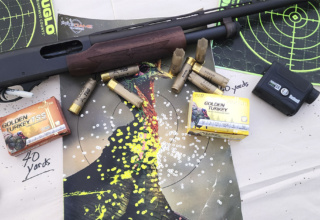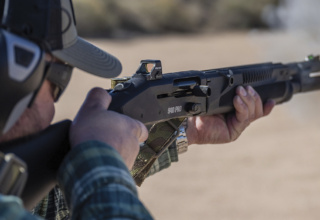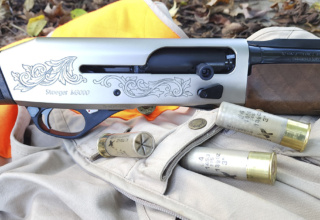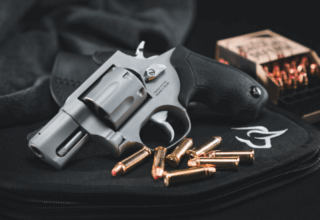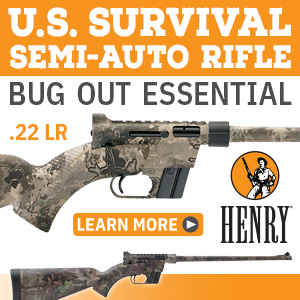Our resident shotgun guru applies his years of training and LE field experience with shotgun incidents to help you navigate your defensive shotgun needs
by Larry Case; lead image courtesy of Mossberg
Except for what is the best cartridge for deer hunting, probably no other debate in the gun world gets as much attention as the “best gun for home defense” circus. I believe in full disclosure from the start, so let me say that my opinions here fall squarely on the shotgun side. From fifty yards in, no other weapon short of a flamethrower can bring as much destruction down on your assailant as the proper shotgun. The AR rifle guys, and certain handgun fans, do not want to hear this, but the truth is what it is. I spent probably too many years in the field as a DNR Law Enforcement Officer and I saw a lot of people shot with shotguns — some lived and some didn’t.
Why is the shotgun best? Two main reasons: range and firepower.
Range here is the distance between you and your aggressor, and home defense confrontations will sometimes be measured in feet, not yards. For our purposes, firepower means how much hot lead we can bring to bear on the target in the shortest amount of time. No firearm yet invented can protect us better from anyone who has entered our home uninvited and intends to bring harm to you and yours than a shotgun.
Twelve gauge 2 ¾-inch #00 buckshot loads generally contain eight or nine .33 caliber pellets per shell. If you fire three rounds at your aggressor in a home defense situation, you have delivered at least 24 .33 caliber projectiles in a short amount of time. Now, we can argue the choices in buckshot and shot size all you like. Think #00 buckshot is too big? Many say that #4 buckshot is a better choice—more pellets per shell (anywhere from 21 to 28 pellets) but still big enough to give good penetration.
Next usually comes the argument for bird shot in the home defense shotgun. In the close range of many home defense encounters (often twenty feet or less), you will find that the size of the shot will not matter too much. At these close ranges, a #7 ½ shot size field load may pattern so tightly that the impact will look more like a slug round than pellets.
In 2017, a Montana pheasant hunter was charged by a grizzly, which he discouraged from chewing on him with a 12-gauge shotgun. The hunter reportedly fired once into the air to get the bear to leave, then shot the bear twice as it charged him, once in the chest and then in the head. The bear ran off and died and the hunter was not harmed.
Believe me when I tell you that getting struck with this load at close range is devastating. (I have seen it more than once, and it ain’t pretty). As the small shot starts to spread, the individual pellets will have less penetration through a wall in the home, but that may be a couple rooms away. Bottom line? Big shot or little shot, the shotgun is the best way to protect you and your family.
Ok, if you are with me so far that the shotgun is the best weapon for home defense, which kind of shotgun is best? Brands of shotguns aside, if we are considering what type shotgun is best, we should be talking about the type or platform of the shotgun, not the make and model.
So, what are the traits of a defensive shotgun?
First, let’s make clear that the “best gun to use is the one in your hand” refrain applies here. If you are involved in a home invasion incident and the only gun available to you is the Model 12 30-inch barrel that Uncle Bill gave you, then that is what you use. To be better prepared though, we would want to have a shotgun designated for fighting, not hunting. Here are some of the basic features of that shotgun.
Barrel Length

Don’t saw the barrel off shorter than the legal length of 18 inches, but a short barrel is definitely advantageous. In the tight quarters of a home defense situation, a long barrel can be a big hindrance. Most tactical shotguns have barrels in the 18- to 20-inch range.
Capacity
More is always better when it comes to ammo. The shotgun only has two disadvantages for home defense work: relatively low magazine capacity and how long it takes to load. You may not need a lot of extra ammunition if you are called upon to defend you and your family, but then again, you might. Most defensive shotguns have an extended magazine tube that can accommodate up to six shells, sometimes more. A “side-saddle” ammo carrier on the gun is also handy.
High-Visibility Sights
For some short-range encounters, the plain bead on most shotguns will get you by but remember…this is a fighting shotgun and we may ask this weapon to do many things. Fast target acquisition is what we are after here.

High visibility rifle sights or an optic can work wonders. When I attended the Defensive Shotgun Class at the Gunsite Academy, I used a Trijicon MRO sight on the Mossberg ATI shotgun and it worked great. Another option might be the Burris Fast Fire 3 optic. A simpler, less expensive option is the HI VIZ Shotgun Compsight. This is a simple front bead replacement which offers tritium and Litepipe technology. The HI VIZ Litepipe gathers ambient light in daytime and the tritium feature gets fast target acquisition at night. We’re also big fans of XS Sights’ Shotrail ghost ring sight with the banded tritium front sight. It’s a simple open sight system that gets you on target quickly in any light condition.
Auxiliary Light
If you can’t see, you can’t fight. You can make do with a good handheld flashlight but a light mounted on the gun, either on the fore-end or on a side-mounted rail (as on the Mossberg ATI I used) is best.
Sling
A sling on a shotgun is the same as a holster for a pistol. If you need to stow it or take your hands off the gun for some reason, you must be able to take it up again quickly. The sling allows you to do this.
Fitment
The 14 ¼-inch length-of-pull for most American shotguns is an attempt to fit most of us that would pick up this gun. You may have noticed that we are all not made the same in height, weight, arm length, neck, and so on. What if we had a shotgun with an adjustable length stock?
One of things most of us do not consider is that we shoot a defensive or fighting shotgun differently than the one we use for wing shooting or on the skeet range. These shotguns are mounted, and we swing on flying targets, which is quite different than aiming at a somewhat stationary target. To help with this, most of us need the stock on the shotgun to be slightly shorter than the standard stock length.
If we do not have this shorter stock, most shooters will find themselves constantly trying to grip closer to the receiver and get a better sight picture down the rib or barrel of the shotgun. This is known as “crawling up the stock” and it is relieved with a shorter stock.
A good example of this is Remington lopping off 1 ¼ inches of LOP on the V3 Turkey Pro—a shotgun meant to be fired sitting at a fixed target (see the Remington V3 Pro Turkey Model shotgun review by yours truly).
The Mossberg 500 ATI
Adjustable stocks, pistol grips, rails, and ammo carriers are widely available to trick out your shotgun. Since this is not Mossberg’s first rodeo, they wisely teamed up with ATI (Advanced Technology International) to supply all the goodies to make a dynamite tactical/defensive shotgun.
The Mossberg 500 ATI is a beast. Take the basic, time-tested Mossberg 590 pump gun, add an ATI adjustable stock, pistol grip, side-saddle ammo carrier, heat shield, and multiple rails for lights and other accouterments. I shot this gun through the entire 260 Shotgun Class at Gunsite Academy in Arizona with four different kinds of ammo and did not have one malfunction. The Mossberg 590 system’s dual extractors, twin action bars, and anti-jam elevator in the mechanism saw to that. As usual for me, I treated this gun pretty rough, did not baby it, and did not even offer to clean it during the time at Gunsite. The ATI Tactical also delivered some very respectful groups with slugs at 100 yards.
Custom Modding Your Shotgun
If you want to convert your present shotgun with tactical options, Mesa Tactical has some good choices. Check out this article, where we install Mesa Tactical’s Telescoping Stock Adapter Kit and SureShell Aluminum Carrier on a Mossberg 500.

It is no secret that shooting full-house buckshot or slug loads is about as much fun as going to the dentist. Mesa Tactical’s LEO Telescoping Hydraulic Recoil stock kits also help with that old demon, felt recoil. These kits come with a Crosshair Hydraulic Recoil Buffer. Mesa Tactical will tell you this feature reduces felt recoil up to 70%. No doubt, such things are hard to measure, but I can tell you that the reduction in recoil is substantial. This part is important. Less felt recoil means most shooters will not be afraid of the gun, which will translate to better accuracy and getting back on target quicker after the shot.
The Remington 870
When talking about dependable shotguns for home defense or anything else, it is almost impossible to not bring up the Remington 870.
The 870 was introduced in 1961 and is the best-selling pump shotgun of all time with now over 11 million sold. Mossberg and Remington fans can argue this all day, but for rugged dependability and peace of mind, go bang when you need it to, the 870 is hard to beat. There are no doubt millions of 870s sitting in bedroom corners and closets doing duty as home defense guns—the same one the owner uses to duck and pheasant hunt. If we add a few tactical features, though, we can up our home defense game.
The 870 Express Tactical features a quick-pointing 18 1/2-inch barrel and includes an extended ported Tactical Rem Choke. It packs a full seven rounds of 2 3/4- or 3-inch 12-gauge firepower with the factory-installed 2-shot extension.
A Word on “Shorties”
We need to mention the shorties like the Remington 870 Tac-14 DM and Mossberg 590 Shockwave. I admit that the first time I saw the Mossberg Shockwave, I thought, “No way this thing is legal.” I was wrong and the Bureau of Alcohol, Tobacco, Firearms, and Explosives has confirmed the 500 Shockwave as a “firearm” (same for the Remington Tac-14 DM) per the Gun Control Act (GCA), but not a Class 3/NFA firearm. Both guns sport a 14-inch barrel and the Shockwave Technologies “birds head” Raptor Grip stock. I initially had some misgivings about the Shockwave and the Tac-14 DM. (The Mossberg is now available in 12- and 20-gauge, and in .410 bore, the Remington in 12- and 20-gauge). I believed these guns would be a good choice for home defense, but I felt they needed some help, and here is why.

Although both fit the need for a compact weapon in tight places, there is a problem with how these guns are fired. Neither the Shockwave nor the Tac-14 should be fired from a shoulder or eye level position, which means they must be shot from the hip. This brings up a problem with accuracy, as even with a cylinder bore barrel, you will find shot patterns to be surprisingly tight at short ranges. I believe practice with this type of firearm is more important than most people think. The “just point it in the general direction” thinking will not work, and you will find this out if you spend any time on the range with these guns. A couple options that will help is a light mounted on the gun or a laser to help you aim the weapon. Both are available from Crimson Trace.
An Inexpensive Option
If you are in the market for a basic home defense shotgun and you may not want to break the bank right now, consider the Stoeger P3000 Defense shotgun. With an 18 ½-inch barrel, a back synthetic stock, the choice of either traditional stock or pistol grip configuration, and a 3-inch chamber, this is a lot of home defense shotgun for an MSRP of $289.00. Trade up later if you want, but this shotgun will throw a lot of buckshot and pellets.
Stoeger has another option in the Freedom Series P3000 Supreme Model. This shotgun, new for this year, has a lot more goodies on it, including an adjustable-for-length-of-pull stock that also folds to the side with a pistol grip configuration. A ghost ring rear sight, sling attachment, 3-inch chamber, a 7+1 magazine capacity, and an 18 ½-inch barrel length round out the features on this gun with an MSRP of $469.00.
Is there a “best” shotgun for home defense? I say no. The best shotgun to defend your home and family is the one that suits you the best. Find that shotgun—the one you are comfortable with—practice, practice, practice, and then have it ready when things go bump in the night.











